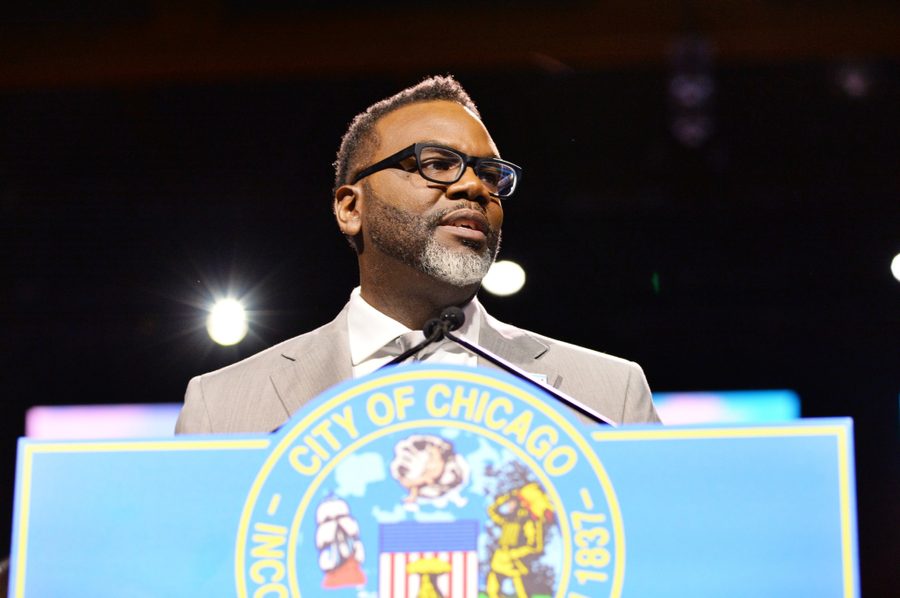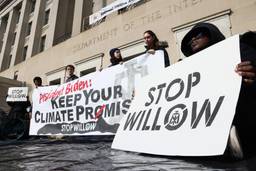Can Mayor Brandon Johnson Create a Green New Deal for Chicago?
Johnson ran on a promise to make environmental justice central to policy making. Now that he’s in office, organizers expect him to deliver.
Kari Lydersen

By the end of his tenure, former Chicago Mayor Richard M. Daley, who held office from 1989 to 2011, became known as “America’s green mayor” by national pundits and supporters. The accolade was awarded thanks to a green roof on City Hall and some tree-planting and bike lanes, even as the city still hosted two archaic coal-fired power plants and a stinking polluted river — and lacked a full recycling program.
“It’s great that Chicago City Hall has a green roof,” new Mayor Brandon Johnson wrote in his campaign platform, “but that commitment to environmental sustainability needs to filter down through the entire building.”
In that vein, Johnson has promised an environmental justice agenda based on a “Green New Deal” for housing, education, clean air and clean water. This means replacing lead water service lines, retrofitting buildings, installing solar, electrifying transit and more. In the process, Johnsons said his administration would create union or prevailing wage jobs, employ people from marginalized and pollution front-line neighborhoods, and prepare youth for advanced clean energy careers.
Now Johnson — who took office Monday after defeating conservative law-and-order candidate Paul Vallas in an April run-off — has the chance to implement his promises, and the timing couldn’t be better.
His ambitious plan dovetails with, and can leverage resources from, a recent state energy law and the federal Inflation Reduction Act (IRA), both of which prioritize environmental justice and equity in creating significant funding and supports for clean energy and sustainability investments.
Illinois’s Climate & Equitable Jobs Act (CEJA), passed in 2021, allocated resources for solar arrays and by extension solar jobs in marginalized communities, including those most impacted by the fossil fuel economy. Rural and downstate Illinois has indeed enjoyed a solar boom thanks to that measure and a 2017 state law with similar provisions.
But Chicago — where for decades two coal plants spewed toxins over low-income immigrant communities — has so far seen little solar development or clean energy employment.
The reasons showcase how difficult it can be to achieve a “just transition” to a cleaner economy. Even when subsidies for solar exist, city dwellers often can’t access solar power if they are renters or have substandard roofs, or are simply too busy with other challenges.
Similarly, Chicagoans were slow to take advantage of solar job training programs, because of difficulties like transportation and childcare, or the fact they never saw solar as a positive for their community.
Installing solar panels on homes and businesses also isn’t usually the kind of union, well-paying, stable job that sustains communities for generations, or helps replace defunct industries like the steel mills that once fostered thriving neighborhoods on Chicago’s Southeast Side. The solar industry can be seasonal and fickle, with demand rising and falling sharply based on availability of subsidies and changing policies.
Bureaucracy and global trade issues can also cause bottlenecks that kill jobs and enthusiasm for the sector. Even as CEJA made solar theoretically available cost-free to many families and funded workforce development hubs across the state, many residents remain on months-long waiting lists to actually get solar, and the workforce hubs are still in very early planning stages and won’t be open any time soon.
Other parts of Johnson’s proposed Green New Deal could be more straightforward to implement, like replacing lead service lines for water and modernizing weatherization and climate controls in public schools. But even those plans are bound to raise logistical challenges and involve potentially long time frames.
An effective mayor not only has bold vision, but figures out how to wade through the countless bureaucratic and political obstacles that too often torpedo good intentions. A successful civic leader, much like a successful community organizer, instinctively takes into account the realities of working people’s lives and the deep ripple effects of systemic injustice, and addresses how those nuances relate to sectors like clean energy job training and vehicle electrification.
As a father from Chicago’s West Side and a former educator and union organizer, Johnson has plenty of first-hand experience with the daily struggles that must be addressed while revamping housing, education and energy.
And he may indeed have the political will and genuine community connections to successfully tap state-level solar and job training resources along with opportunities created by the IRA.
The IRA includes the “Justice40 Initiative,” a promise that 40% of the benefits of federal clean infrastructure and energy investments should “flow to disadvantaged communities that are marginalized, underserved, and overburdened by pollution.”
The federal government needs local leadership and networks to even begin to realize such a lofty goal. And Johnson’s administration could be well-poised to help Black and brown communities — which for decades have borne the brunt of pollution with few economic benefits — take advantage of programs like electric school buses, electric vehicle charging infrastructure, solar energy, and clean energy-related manufacturing.
“Fortunately thanks to the IRA, much of the funding is there,” said Jack Darin, director of the Illinois chapter of the Sierra Club and a member of Johnson’s transition team environmental justice subcommittee.
“This is a really rare moment in history where you’ve got some very bold ideas that actually match up really well to currently available funding sources. It really is a convergence that’s pretty exciting for Chicago — with the money and programs available from both the federal and state government and an incoming mayor who really sees the urgency of the climate crisis, but also the economic opportunity and chance to build a more equitable Chicago.”
Even as local, state and federal agencies across the country have increasingly promised equity, just transition and environmental justice, community leaders have demanded “nothing about us without us” — real seats at the table as policy is developed and implemented.
The environmental justice subcommittee that Johnson appointed as part of his transition team could bode well for such an inclusive process. It includes community leaders and experts like Olga Bautista, Naomi Davis and Juliana Pino, who successfully fought over many years for grassroots environmental justice groups to have real say in state and local policy.
It’s a process that happened sometimes painfully over more than two decades in Chicago. When international NGOs took up the Chicago coal plants as a symbol of the global campaign against coal, members of the Little Village Environmental Justice Organization (LVEJO), where Pino is policy director, refused to simply serve as the local faces of color at press conferences. They became technical experts and leaders in both the public campaigns and back-room political negotiations around the coal plants and other environmental issues.
Attorney Naomi Davis, founder of the grassroots group Blacks in Green, has long proven that communities of color do not need to accept the false tradeoff between jobs and the environment, demanding equitable and sustainable development on Chicago’s South Side.
Bautista was among the residents of Chicago’s Southeast Side who raised hell when towering piles of toxic petroleum coke rose in their community, and when proposals for new polluting industries like a coal gasification plant and metal shredder run by General Iron were offered as supposed “opportunities” for a community reeling from the closing of steel mills.
Ultimately, city and state officials were forced to take action to ban petcoke storage, and the proposal to move General Iron from wealthy Lincoln Park on the North Side to the poorer Southeast Side was defeated and sparked a federal civil rights investigation.
“We’re getting to a sweet spot where we’re able to change policy — everyday people, moms and dads, grandmas and grandpas,” Bautista told me back in 2018, after the petcoke victory helped local residents mobilize against manganese emissions from a local factory.
The Southeast Side’s saga underscores how Johnson’s mission in building an environmentally just Chicago cannot only consist of positive projects such as a boom in clean energy and electric vehicles, a greening of buildings and creation of jobs. It also means saying “no” to powerful players, cracking down on polluters and implementing and enforcing meaningful regulations.
And those powerful entities are bound to fight back. General Iron filed a lawsuit when former Mayor Lori Lightfoot’s administration denied the permit for moving to the Southeast Side, after — the company says — indicating the city would allow it.
Polluting companies ranging from an asphalt plant on the South Side to the former owner of the city’s coal plants have long showered City Council members with political campaign contributions, making it harder to pass ordinances or take other measures that require Council approval.
And such companies have a long record of trying to win community approval by promising jobs, giving out small grants and “greenwashing” their projects, muddying the waters as elected officials try to consolidate political will against polluters.
Johnson will need City Council approval to fulfill his promise to pass the proposed Cumulative Impact Ordinance, pushed by Bautista and other leaders, which would “pump the brakes on the permitting of additional industrial facilities” in communities already overburdened by pollution.
This has long been a demand of activists on the Southeast Side, who note that a proposal for any given project cannot be considered in isolation from a long history of pollution in areas that have been treated as “sacrifice zones” for far too long.
Johnson has promised to reinstate the city’s Department of Environment, which was abolished by former Mayor Rahm Emanuel, even as Emanuel, like Daley, gained national accolades for being a leader on climate and sustainability.
Emanuel made the Chicago public health department responsible for enforcing pollution laws, but the city’s inspector general and community groups found that the department failed to conduct inspections and allowed companies to pollute the air with little accountability.
With a gun violence crisis and other issues that may seem more urgent, politicians can be hard-pressed to prioritize the often slow work of environmental justice and mitigation. But Darin and other civic leaders said they have high expectations.
“I’m hopeful the new administration will take an integrated approach, and see how they can solve multiple problems at the same time,” said Anne Evens, CEO of Elevate, the clean energy non-profit tasked with implementing equity provisions of the state law. Elevate COO Delmar Gillus is on Johnson’s transition team.
“When you invest in communities, crime goes down,” Evens continued. “That is why one of the things he’s leading with is employing youth. I’m hopeful this administration doesn’t see it as ‘either-or’ but ‘yes, and.’ That’s how we make solutions happen.”
Kari Lydersen is a Chicago-based journalist, author and assistant professor at Northwestern University, where she leads the investigative specialization at the Medill School of Journalism, Media, Integrated Marketing Communications. Her books include Mayor 1%: Rahm Emanuel and the Rise of Chicago’s 99%.








